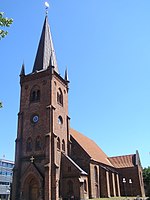Vejle

Vejle (Danish pronunciation: [ˈvɑjlə]) is a city in Denmark, in the southeast of the Jutland Peninsula at the head of Vejle Fjord, where the Vejle River and Grejs River and their valleys converge. It is the site of the councils of Vejle Municipality (kommune) and the Region of Southern Denmark. The city has a population of 61,310 (as of 1 January 2023) making it the ninth largest city in Denmark. Vejle Municipality has a population of 120,949 (as of 2023) making it the fifth largest municipality in Denmark. The city is part of the Triangle Region, which includes the neighbouring cities of Kolding and Fredericia and it is located 110 kilometres (68 miles) north of Germany. Vejle is most known for its forested hills, fjord, harbour, shopping, pedestrian mall, and windmill.
Excerpt from the Wikipedia article Vejle (License: CC BY-SA 3.0, Authors, Images).Vejle
Grejsdalsvej, Vejle Grejsdal
Geographical coordinates (GPS) Address Nearby Places Show on map
Geographical coordinates (GPS)
| Latitude | Longitude |
|---|---|
| N 55.716666666667 ° | E 9.5333333333333 ° |
Address
Grejsdalsvej 9
7100 Vejle, Grejsdal
Region of Southern Denmark, Denmark
Open on Google Maps










